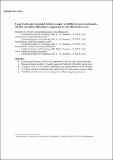Files in this item
Large Carbonate Associated Sulfate isotopic variability between brachiopods, micrite, and other sedimentary components in Late Ordovician strata
Item metadata
| dc.contributor.author | Present, Theodore | |
| dc.contributor.author | Paris, Guillaume | |
| dc.contributor.author | Burke, Andrea | |
| dc.contributor.author | Fischer, Woodward | |
| dc.contributor.author | Adkins, Jess | |
| dc.date.accessioned | 2016-11-04T00:33:42Z | |
| dc.date.available | 2016-11-04T00:33:42Z | |
| dc.date.issued | 2015-12-15 | |
| dc.identifier | 223453094 | |
| dc.identifier | 51946374-56b1-47da-b982-ab2287271433 | |
| dc.identifier | 84944733285 | |
| dc.identifier.citation | Present , T , Paris , G , Burke , A , Fischer , W & Adkins , J 2015 , ' Large Carbonate Associated Sulfate isotopic variability between brachiopods, micrite, and other sedimentary components in Late Ordovician strata ' , Earth and Planetary Science Letters , vol. 432 , pp. 187-198 . https://doi.org/10.1016/j.epsl.2015.10.005 | en |
| dc.identifier.issn | 0012-821X | |
| dc.identifier.other | ORCID: /0000-0002-3754-1498/work/64034539 | |
| dc.identifier.uri | https://hdl.handle.net/10023/9759 | |
| dc.description | Funding for this work was provided by the American Chemical Society Petroleum Research Fund New Directions grant #53994-ND2, NSF Division of Earth Sciences award EAR-1349858, and the Agouron Institute grant AI-GC17.09.3 | en |
| dc.description.abstract | Carbonate Associated Sulfate (CAS) is trace sulfate incorporated into carbonate minerals during their precipitation. Its sulfur isotopic composition is often assumed to track that of seawater sulfate and inform global carbon and oxygen budgets through Earth’s history. However, many CAS sulfur isotope records based on bulk-rock samples are noisy. To determine the source of bulk-rock CAS variability, we extracted CAS from different internal sedimentary components micro-drilled from well-preserved Late Ordovician and early Silurian-age limestones from Anticosti Island, Quebec, Canada. Mixtures of these components, whose sulfur isotopic compositions vary by nearly 25‰, can explain the bulk-rock CAS range. Large isotopic variability of sedimentary micrite CAS (34S-depleted from seawater by up to 15‰) is consistent with pore fluid sulfide oxidation during early diagenesis. Specimens recrystallized during burial diagenesis have CAS 34S-enriched by up to 9‰ from Hirnantian seawater, consistent with microbial sulfate reduction in a confined aquifer. In contrast to the other variable components, brachiopods with well-preserved secondary-layer fibrous calcite—a phase independently known to be the best-preserved sedimentary component in these strata—have a more homogenous isotopic composition. These specimens indicate that seawater sulfate remained close to about 25‰ (V-CDT) through Hirnantian (end-Ordovician) events, including glaciation, mass extinction, carbon isotope excursion, and pyrite-sulfur isotope excursion. The textural relationships between our samples and their CAS isotope ratios highlight the role of diagenetic biogeochemical processes in setting the isotopic composition of CAS. | |
| dc.format.extent | 8974346 | |
| dc.language.iso | eng | |
| dc.relation.ispartof | Earth and Planetary Science Letters | en |
| dc.subject | Multi-collector inductively coupled plasma mass spectrometry | en |
| dc.subject | MC-ICP-MS | en |
| dc.subject | Sulfur isotopes | en |
| dc.subject | Hirnantian | en |
| dc.subject | Silurian | en |
| dc.subject | Diagenesis | en |
| dc.subject | GB Physical geography | en |
| dc.subject | DAS | en |
| dc.subject.lcc | GB | en |
| dc.title | Large Carbonate Associated Sulfate isotopic variability between brachiopods, micrite, and other sedimentary components in Late Ordovician strata | en |
| dc.type | Journal article | en |
| dc.contributor.institution | University of St Andrews. Earth and Environmental Sciences | en |
| dc.contributor.institution | University of St Andrews. St Andrews Isotope Geochemistry | en |
| dc.identifier.doi | 10.1016/j.epsl.2015.10.005 | |
| dc.description.status | Peer reviewed | en |
| dc.date.embargoedUntil | 2016-11-03 | |
| dc.identifier.url | http://www.sciencedirect.com/science/article/pii/S0012821X15006330#appd002 | en |
This item appears in the following Collection(s)
Items in the St Andrews Research Repository are protected by copyright, with all rights reserved, unless otherwise indicated.

